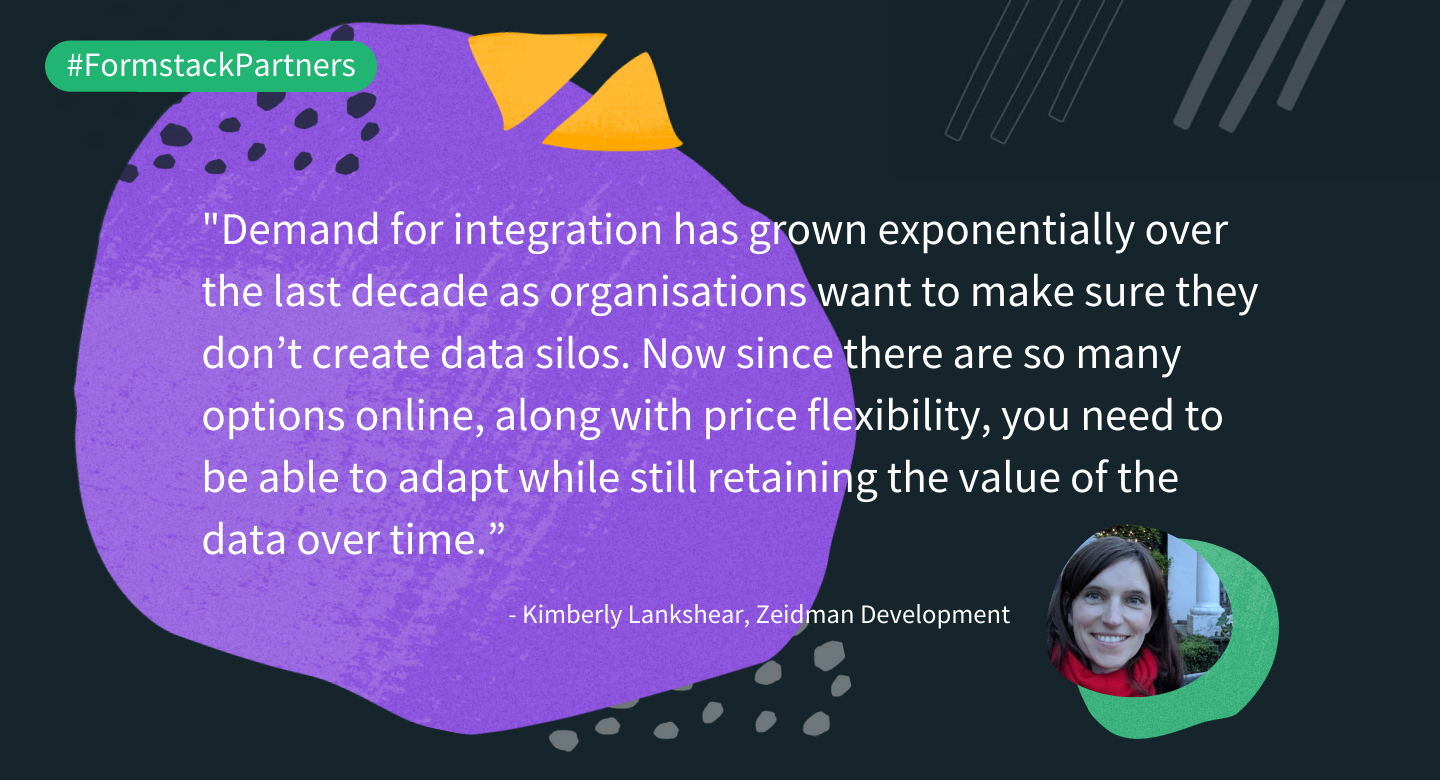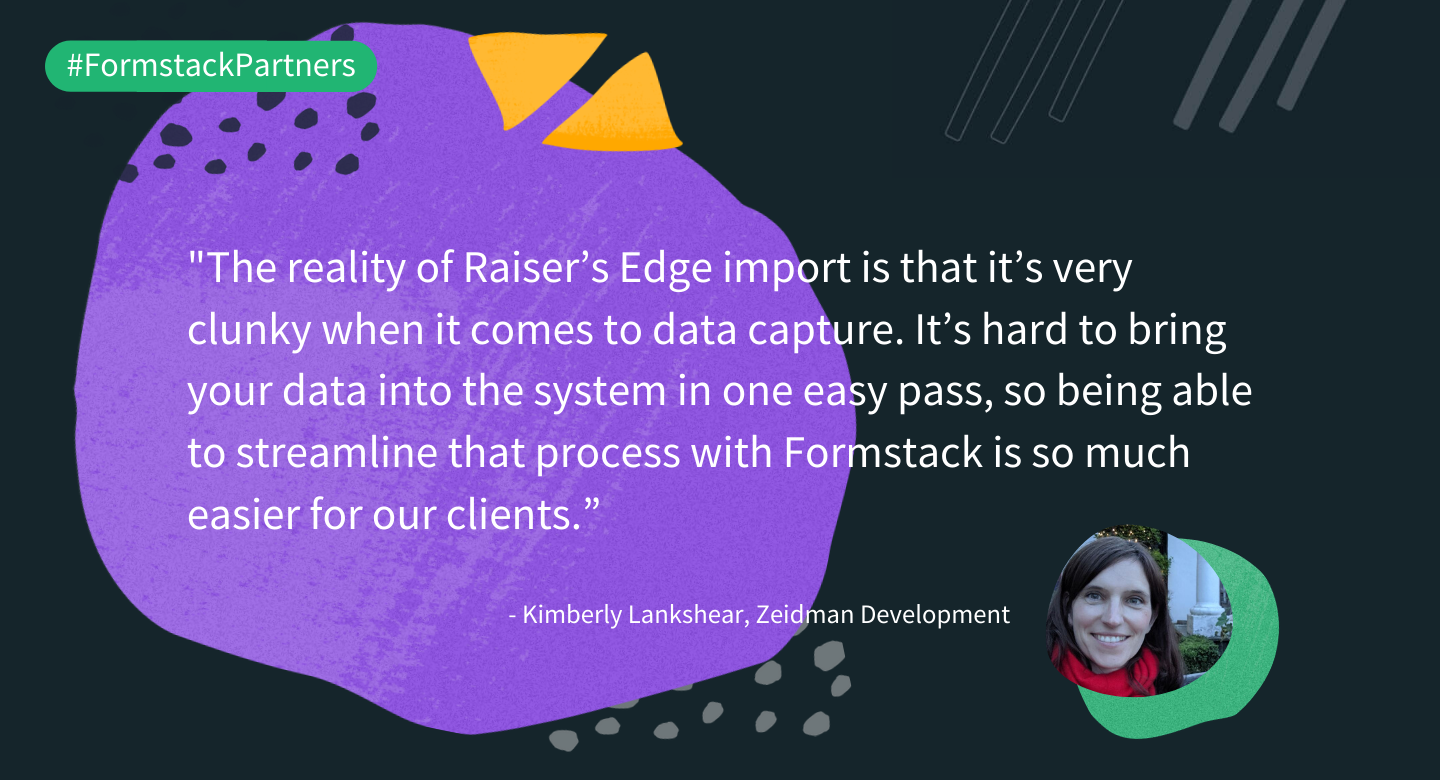Our VP of Partnerships Zak Pines recently sat down with Kimberly Lankshear, Business Development Manager at Zeidman Development, as part of our ongoing Partner Interview Series. Zak and Kimberly had a far-ranging conversation that touched on Blackbaud’s Raiser’s Edge products; her work in the nonprofit space; growth in technology adoption; and the importance of user-friendly tools. Here’s an abridged transcript of the chat.
Zeidman Development Background
Zak: Can you start by telling me what Zeidman does?
Kimberly: We focus on serving customers of Blackbaud and their Raiser’s Edge, Raiser’s Edge NXT, BBCRM, and Altru product lines—specifically integrations with other products. I’ve been with Zeidman for almost 10 years.
We are based in the UK, as are many of our customers. We also have customers all over the world, including large numbers in the US and Canada, as well as Australia, New Zealand, Singapore, and Hong Kong.
Zak: Can you share more background on Blackbaud for those who are not familiar?
Kimberly: Blackbaud is a large player globally serving nonprofits for their fundraising and CRM needs. They have offices in Europe, the US, Australia, and various locations around the world. They service all types of nonprofits, healthcare, faith-based charities, schools and higher education, traditional nonprofits, and everything in between.
Zak: What is the focus of Zeidman’s services?
Kimberly: The focus of what we do is providing integrations for Raiser’s Edge and Raiser’s Edge NXT. We also provide consultancy and training as well as bespoke customizations.
Zak: Great. Let’s dive into your role and responsibilities. What is your role in the business?
Kimberly: I wear many hats. I’m focused on sales and discovery, but I also do customer support, training, partner management; and I look after our website. I do marketing and am responsible for our conference presence as well. Business development is probably the best way to put it.
Zak: You’re a jack of all trades!
Kimberly: Jack of all trades, master of none!
Zak: So how did you get into this space? You’ve been with the business for 10 years?
Kimberly: Yes, nearly 10 years! I started off working with charities in 2007. I worked for the Scout Association, which is the UK equivalent of Boy Scouts. I worked for a couple of charities who were governing bodies for charities and grant-making for charities, and I worked at a grant-making charity managing CSR. So I’ve worked across the spectrum of charitable organizations.
The opportunity for Zeidman Development felt like a good fit after that because I had a good understanding of the sector and a lot of contacts within it. I knew David Zeidman, the founder of the company, from my previous work and knew he was good at what he does and well respected in the sector.
Advancement in Technology for Nonprofits
Zak: So you’ve been in the company for almost a decade and the nonprofit space for longer. Do you have any commentary on what’s happening in this space as it relates to the technology and technology adoption? What are you seeing in this space?
Kimberly: When I first started in the nonprofit sector, all of these online services were just emerging. People were just getting started with online mailing services and event management websites; this was all essentially being done for the first time, and new, cool stuff was available. The adoption of that over the last 10 years has massively increased. But integration with traditional systems has been slow to follow. I think that’s partly because many are still using older systems, and Blackbaud is a key example. It’s software that fundraisers love, but it was originally created a long time ago; it’s playing catch-up with the availability of SaaS, but it can’t do everything.
Zak: That’s where you come in.
Kimberly: Yes, that’s the gap we fill. If everyone is using all of these tools, but they want to use Raiser’s Edge, which is a great tool, then we offer the integration. Demand for integration has grown exponentially over the last decade as organisations want to make sure they don’t create data silos. Now since there are so many options online, along with price flexibility, you need to be able to adapt while still retaining the value of the data over time.

Discovering Formstack
Zak: Do you recall along the way when you first discovered Formstack?
Kimberly: I used Formstack before I started working at Zeidman Development. We used it for customer surveys when I was working at the Institute of Fundraising. It was such an easy tool to use—really user-friendly for both the person building the form and the person filling out the form.
Zak: How are you using Formstack now at Zeidman Development?
Kimberly: We’ve been using Formstack for various tasks internally, and then specifically when we were building Importacular, our import tool. We were creating integrations with various online systems, and so we used Formstack during that process.
Then, a client came to us with a bigger project than just the integration. They wanted us to revitalize their entire process from start to finish, which would include the integration piece and bringing the data into Raiser’s Edge. We realized integration between Formstack and Raiser’s Edge would be key, because we could do what they wanted right within Formstack. Plus, it was flexible and user-friendly, while having the ability to make it as sophisticated as they needed it to be and still maintain its ease of use. Conditional Logic was key, so a form would only display the fields people needed to fill in. The client could do this easily within Formstack, compared to trying something custom or working within their existing technologies.
That’s when we realized Formstack was much more powerful than what we’d been using it for.
Zak: OK got it. So the opportunity you saw was to use Formstack to give Raiser’s Edge customers very flexible data collection tools, and then feed that data into Raiser’s Edge via your Importacular tool.
Can you tell me more about the use case for that particular customer using Formstack with Raiser’s Edge?
Kimberly: The organization had a volunteer phone line, and the volunteers had to collect data over the phone and put it into a form. Using Raiser’s Edge for this process isn’t user-friendly because it’s easy to make mistakes or input data incorrectly and requires a lot of user training. The Formstack form took the stress away. You could easily input data and put it back into the organization’s CRM. If there were any errors, we could clean it up. We’re also dealing with very sensitive data, so it was important it was secure and users felt confident with the system they were inputting data into.
Zak: So the Formstack integration makes the data collection process more intuitive to capture and collect the data accurately, while also doing it in a highly secure way because there was sensitivity in that data. And this is all while ensuring that it could be fed into Raiser’s Edge as the system of record for the nonprofit.
Kimberly: Exactly! And now we have this as a standard Formstack-Raiser’s Edge integration, which we can provide to any Formstack customer looking to feed Formstack data into Raiser’s Edge.
Zak: Fantastic.
Kimberly: Yes, a customer can activate the integration on their own. It’s very much self-service as we’re enabling them to integrate as they need to and create what they need to in a very user-friendly way with complete flexibility. That’s the beauty of it!
Formstack & Raiser’s Edge
Zak: How does the integration work with Raiser’s Edge?
Kimberly: Via the API, it pulls all fields from the form. And then you can create your own mapping template. We have an interface that shows you Raiser’s Edge fields that are available and then you have Formstack form fields. From there, you create the template, set it up, and save it. Every time you use Formstack you can reuse that template or create different templates for different forms.
Zak: So if you’re a company using Blackbaud and Raiser’s Edge, and you want more flexibility with how you collect and capture data into Raiser’s Edge, Zeidman Development’s tools can help you set up your Formstack forms, set up the integration, and collect the data much more effectively and accurately?
Kimberly: That’s right. The reality of Raiser’s Edge import is that it’s very clunky when it comes to data capture. It’s hard to bring your data into the system in one easy pass, so being able to streamline that process with Formstack is so much easier for our clients. And we do this through connecting Formstack and Raiser’s Edge with Importacular. It’s secure, in one pass, and—again, I go back to this concept—user-friendly for both the builder and the person filling out the form.

Zak: Knowing Formstack can be configured to collect any kind of information, can you share some of the ways a nonprofit can use Formstack and have Zeidman help them ensure it’s a seamless process with Raiser’s Edge?
Kimberly: The power of Formstack is its total flexibility. You can collect basic information on people, such as their biographical information. But you can also collect event information, so you can then populate the participant areas of Raiser’s Edge. You can collect donations and bring that into the donation section of Raiser’s Edge. You can collect volunteer signups and add that to the volunteer area of Raiser’s Edge.
Raiser’s Edge has all of these modules that allow you to manage your data, and Formstack enables you to collect the information in an easy way. The possibilities are limitless.
Lightning Round
Zak: Let’s wrap up with our Lightning Round! Do you have any personal interests or hobbies you would like to share?
Kimberly: Running in the woods.I’m a five-minute walk away from the nearest woodlands; that’s what I do with my free time.
Zak: Do you have a productivity tip you can share? How do you stay productive in a busier and busier world?
Kimberly: I use the pomodoro technique, which is where you work on set tasks in 20 minute bursts. Set a timer for 20 minutes, and you focus on one task for that 20 minutes. After that you can do something different, but within that time, there are no interruptions, no checking email, no checking your phone, just cracking on with whatever you’re doing.
Zak: That’s a great tidbit right there! Do you have a favorite TV show?
Kimberly: I don’t really watch a lot of television! I watch films. I’ve been watching lots of documentaries recently. The Metallica documentary was excellent.
Zak: What’s your go-to lunch during the work day?
Kimberly: I work at home, so I can make myself anything. Usually eggs and something green. I try to be healthy.
Zak: Last question. Is a hot dog a sandwich?
Kimberly: Certainly not!
Looking for your next step? Check out Formstack’s partner program for consultants, agencies, and tech partners.











